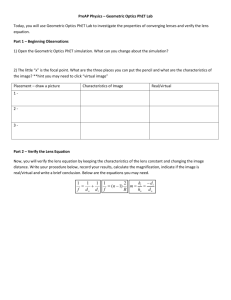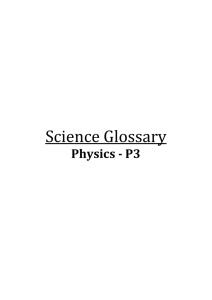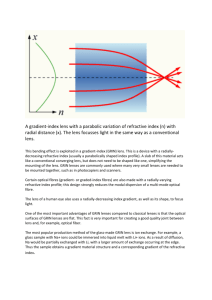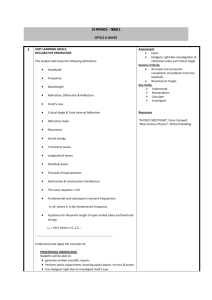OPT 1110 - Florida State College at Jacksonville
advertisement
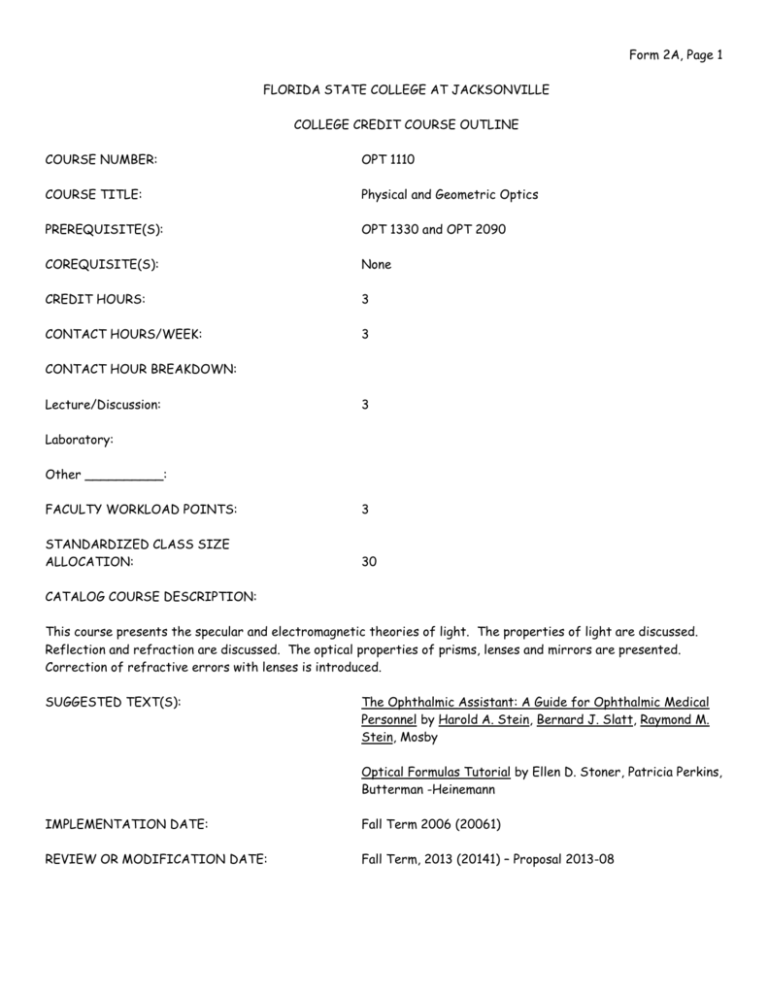
Form 2A, Page 1 FLORIDA STATE COLLEGE AT JACKSONVILLE COLLEGE CREDIT COURSE OUTLINE COURSE NUMBER: OPT 1110 COURSE TITLE: Physical and Geometric Optics PREREQUISITE(S): OPT 1330 and OPT 2090 COREQUISITE(S): None CREDIT HOURS: 3 CONTACT HOURS/WEEK: 3 CONTACT HOUR BREAKDOWN: Lecture/Discussion: 3 Laboratory: Other __________: FACULTY WORKLOAD POINTS: 3 STANDARDIZED CLASS SIZE ALLOCATION: 30 CATALOG COURSE DESCRIPTION: This course presents the specular and electromagnetic theories of light. The properties of light are discussed. Reflection and refraction are discussed. The optical properties of prisms, lenses and mirrors are presented. Correction of refractive errors with lenses is introduced. SUGGESTED TEXT(S): The Ophthalmic Assistant: A Guide for Ophthalmic Medical Personnel by Harold A. Stein, Bernard J. Slatt, Raymond M. Stein, Mosby Optical Formulas Tutorial by Ellen D. Stoner, Patricia Perkins, Butterman -Heinemann IMPLEMENTATION DATE: Fall Term 2006 (20061) REVIEW OR MODIFICATION DATE: Fall Term, 2013 (20141) – Proposal 2013-08 Form 2A, Page 2 COURSE TOPICS CONTACT HOURS PER TOPIC I. Physical Properties of Light 12 II. Geometric Optics 12 III. Lenses 9 IV. Physiologic Optics 5 V. Correction of Human Refractive Errors 4 VI. Practical Application of Geometric Optics 3 45 Form 2A, Page 3 PROGRAM TITLE: Ophthalmic Technician COURSE TITLE: Physical and Geometric Optics CIP NUMBER: 1351180301 Florida Department of Education Student Performance Standards 07.0 RECOGNIZE AND PRACTICE INFECTION CONTROL PROCEDURES–The student will be able to: 07.01 Define principles of infection control including standard and transmission based precautions. 07.02 Demonstrate knowledge of medical asepsis and practice procedures such as hand-washing and isolation. 07.03 Demonstrate knowledge of surgical asepsis. 07.04 Describe how to dispose correctly of biohazardous materials according to appropriate government guidelines such as OSHA. 11.0 APPLY BASIC MATH AND SCIENCE SKILLS–The student will be able to: 11.01 11.02 11.03 11.04 11.05 11.06 11.07 11.08 11.09 14.0 DEMONSTRATE ANATOMICAL AND FUNCTIONAL OCULAR MEASUREMENTS–The student will be able to: 14.01 14.02 14.03 14.04 15.0 Draw, read, and report on graphs, charts and tables. Measure time, temperature, distance, capacity, and mass/weight. Make, use and convert using both traditional and metric units. Make estimations and approximations and judge the reasonableness of the result. Convert from regular to 24 hour time. Demonstrate ability to evaluate and draw conclusions. Organize and communicate the results obtained by observation and experimentation. Ask appropriate scientific questions and recognize what is involved in experimental approaches to the solution of such questions. Calculate ratios. Describe the principles of human physiology. Identify and describe tissues and cellular structures of the eye. Apply the correct medical terminology to body structures and functions of the eye. Identify cause and effect of the most common pathological conditions of each body system as they relate to the eye. DEMONSTRATE TESTING OF OCULAR FUNCTIONS (INCLUDING VISUAL ACUITY AND VISUAL FIELDS) –The student will be able to: 15.01 15.02 15.03 Describe the interaction of light, lenses, laws of optics. Describe optical properties of the human eye. Measure objectively and subjectively the refractive state of the eye. Form 2A, Page 4 18.0 DEMONSTRATE THE CARING FOR AND MAINTAINING OF OPHTHALMIC INSTRUMENTS–The student will be able to: 18.01 18.02 Describe the fundamental principles of the maintenance, inventory control, and ordering of ophthalmic instruments. Maintain a clinic inventory of the instruments. Describe the appropriate safety/security procedures for the instruments. Form 2A, Page 5 Student Performance Standards CoA-omp Accreditation Standards Physical properties of light General Outcomes: 1.0 The student will be able to describe the propagation of light rays Specific Learning Objectives: Upon completion of this unit, the student should be able to: 1.1 Discuss the wave nature of light 1.2 List forms of energy 1.3 Discuss the Quantum theory of light 1.4 Explain the electromagnetic theory 1.5 Describe the electromagnetic spectrum 1.6 Discuss the visible spectrum 1.7 Discuss infrared and ultraviolet radiation 1.8 List and define terminology of light 1.9 Discuss properties of light of illuminance, luminance and polarization 1.10 Discuss reflection of light rays 1.11 Describe refraction of light rays 1.12 Explain absorption of light rays Geometric Optics General Outcomes: 2.0 The student will describe how light rays are affected by prisms and lenses, and the resulting image formation Specific Learning Objectives: Upon completion of this unit, the student should be able to: 2.1 Discuss the speed of light in air and other medium 2.2 Describe the index of refraction of Snell’s law 2.3 Describe the reflection on a plane surface 2.4 Discuss reflection on a curved surface 2.5 Discuss refraction of light through a medium 2.6 Explain the refraction of light through a prism 2.7 Discuss the prism diopter 2.8 Calculate prism power using the formula P = C/D Lenses General Outcomes: 3.0 The student will be able to discuss refraction light rays through a lens Specific Learning Objectives: Upon completion of this unit, the student should be able to: 3.1 Describe the properties of a convex lens 3.2 Describe the properties of a concave lens 3.3 Discuss vergence of light rays through a lens 3.4 Explain the real or virtual focal point of a convex or concave lens 3.5 Calculate the dioptric power or focal length of a lens using the formula D=1/F 3.6 Discuss the object-image relationship of convex and concave lenses Form 2A, Page 5 Student Performance Standards CoA-omp Accreditation Standards (Continued) 3.7 3.8 3.9 3.10 Explain image formation of a convex or concave lens Differentiate between spherical and cylindrical lenses Explain the Conoid of Sturm Describe refraction through a cylinder lens Physiologic Optics General Outcomes: 4.0 The student will be able to discuss the refractive properties of the human eye, and the role of accommodation. Specific Learning Objectives: Upon completion of this unit, the student should be able to: 4.1 Describe the optical system of the eye 4.2 Discuss obtaining a clear image through the eye 4.3 Explain the process of accommodation 4.4 Discuss the amplitude of accommodation and changes with age 4.5 List the errors of refraction of the human eye 4.6 Discuss the role of the axial length in refraction 4.7 Explain myopic refractive errors 4.8 Explain hyperopic refractive errors 4.9 Differentiate between regular and irregular astigmatism Correction of Refractive Errors General Outcomes: 5.0 The student will gain a working knowledge of the lenses used to correct errors of refraction Specific Learning Objectives: Upon completion of this unit, the student should be able to: 5.1 Discuss lenses used to correct hyperopia 5.2 Discuss lenses used to correct myopia 5.3 Describe spherocylinder lenses used to correct regular astigmatism 5.4 Discuss methods of vision correction following cataract surgery 5.5 Discuss theory and methods of refractive surgery Practical Application of Geometric Optics General Outcomes: 6.0 The student will be introduced to geometric optics in lens systems used for low vision, equipment used in the eye care industry, lasers, and other applications. Specific Learning Objectives: Upon completion of this unit, the student should be able to: 6.1 6.2 6.3 6.4 Discuss magnification Describe optical systems used for low vision patients List ophthalmic equipment that utilize geometric optical properties Discuss lasers used in eye care and other applications Florida State College At Jacksonville Course Learning Outcomes & Assessment NOTE: Use either the Tab key or mouse click to move from field to field. The box will expand to accommodate your entry. Section 1 SEMESTER CREDIT HOURS (CC): 3 CONTACT HOURS (NCC): COURSE PREFIX AND NUMBER: OPT 1110 COURSE TITLE: Physical Geometric Optics Section 2 TYPE OF COURSE: (Click on the box to check all that apply) AA Elective AS Required Professional Course College Prep AS Professional Elective AAS Required Professional Course Technical Certificate Other PSAV Apprenticeship General Education: (For General Education courses, you must also complete Section 3 and Section 8) Section 3 (If applicable) INDICATE BELOW THE DISCIPLINE AREA FOR GENERAL EDUCATION COURSES: Communications Social & Behavioral Sciences Natural Sciences Humanities Mathematics Section 4 INTELLECTUAL COMPETENCIES: Reading Speaking Critical Analysis Writing Listening Information Literacy Quantitative Skills Ethical Judgment Scientific Method of Inquiry Working Collaboratively Section 5 STATE GENERAL EDUCATION LEARNING OUTCOME AREA Critical Communication Scientific and Quantitative Reasoning Thinking Information Global Sociocultural Responsibility Literacy Section 6 LEARNING OUTCOMES Make estimations and approximations and 2 judge the reasonableness of the result Demonstrate ability to evaluate and draw 3 conclusions Organize and communicate the results obtained by observation and 4 experimentation Ask appropriate scientific questions and recognize what is involved in experimental 5 approaches to the solution of such questions. Describe the principles of human physiology 6 Identify and describe tissues and cellular structures of the eye Type of Outcome: Gen. Ed, Program, Course METHOD OF ASSESSMENT Gen Ed Written examinations, projects Gen Ed Written examinations, projects Course Written examinations, projects Program Written examinations, projects Program Written examinations, projects Program Written examinations, projects Section 6 (continued) LEARNING OUTCOMES Apply the correct medical terminology to body structures and functions of the eye Identify cause and effect of the most common pathological conditions of each body system as they relate to the eye Describe the interaction of light, lenses, laws of optics Describe optical properties of the human eye Measure objectively and subjectively the refractive state of the eye Type of Outcome: Gen. Ed, Program, Course METHOD OF ASSESSMENT Program Written examinations, projects Program Written examinations, projects Program Written examinations, projects Program Written examinations, projects Program Written examinations, projects Section 7 Name of Person Completing This Form: Pattie Lamell Date: 2/15/13
